Increased interest in sustainability practices in mezcal is reviving an old tradition
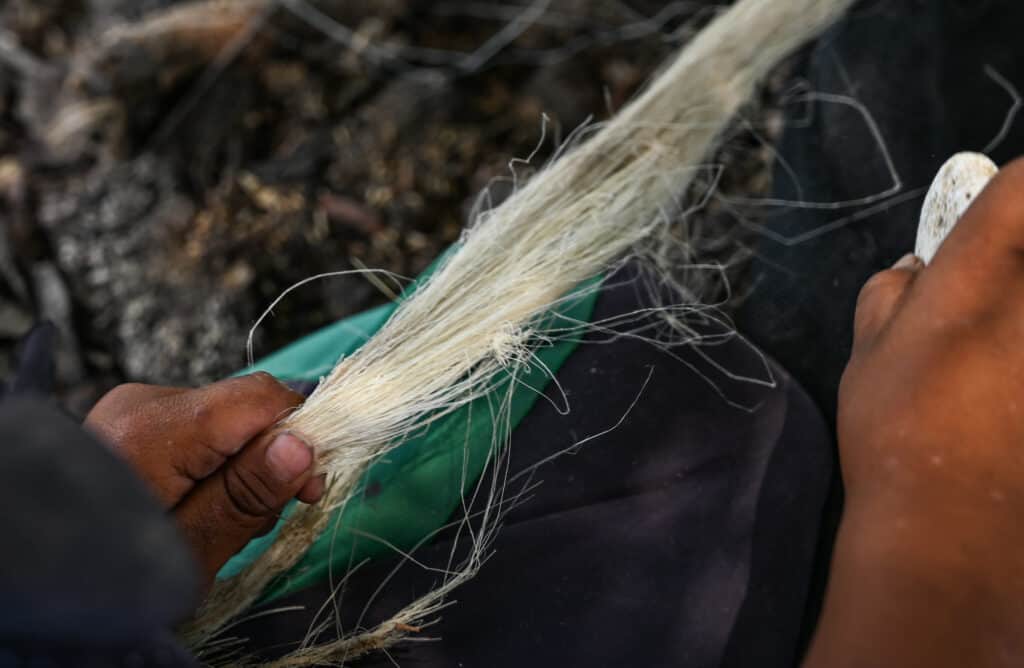
Sustainability is a buzzword that continues to drive contemporary design, ranging from construction to spirits. Corresponding with a timeline of growth in the agave industry, there has been innovative design coming from Oaxaca, with a focus on natural materials, collaborating with local artisans. Innovation often comes from necessity. In this case a necessity to recycle waste products from the boom in mezcal.
This year, leading design fair Maison & Objet, titled their January event ‘Take Care!’ The aim was to reflect consumer interest in natural materials, respecting the origins of products, manufacturing methods, and the commitments of companies. Trends for 2023 were predicted to embrace the natural qualities of materials, stripped of all synthetics.
Agave fibers have been harvested to make ropes and nets for thousands of years. They offer great potential as a sustainable choice with a rich, textural aesthetic, and it is exciting to see a rise in the use of agave fiber for contemporary design. These fibers can be recycled from the ever growing spirits industry, in the form of bagazo and the discarded agave leaves.
Agave leaves are too high in pectins and low in sugars, essentially too fibrous, to be used for making spirits. Yet they make up a substantial part of the plant. You can see piles of the dried leaves in bundles at palenques. Traditionally they are used for stoking fires in the pit oven, distillery or under a comal. Otherwise they are left in the fields, a lattice between rows of agave, which can help protect the top-soil from drying out.
However, as the mezcal market continues to grow, there are more discarded leaves than can be used. Tons of plant matter is discarded. According to Vincente Reyes, founder of Hermano Maguey, these decomposing leaves create an imbalance in the ecosystem, negatively affecting the chemical makeup of the fields. He says that the sheer quantity releases inert gasses that contribute to climate change, a change that is apparent here in Oaxaca, as the weather has become progressively erratic.
THE SUSTAINABLE AGAVE
Hermano Maguey is Oaxaca based, and is a leading initiative in the recycling and processing of agave fiber, specifically from the discarded leaves of espadin. Espadin is the agave variety found most, growing domestically in Oaxaca fields and distilled in massive quantities for mezcal.
In 2022 more than 50,000 leaves were recovered by Hermano Maguey to produce more than 1000 kg of fiber that “were sold to our partner clients who have positioned the fiber as a desirable material for the design & art industry.”
In February 2022, in the pursuit of cultural heritage conservation, Hermano Maguey started F I B R A, an extension project with a commitment to bringing the fiber closer to artisan communities native from the state of Oaxaca. For the last year, Hermano Maguey has created a variety of products in collaboration with 25 artisans from eight communities and developed a network of commercial partners to make their efforts sustainable.
The team behind Hermano Maguey aims to create links between traditional knowledge and modern commercial networks, a “community development project focused on the inclusion of indigenous families in sustainable maguey harvest systems and the use of its bioproducts.” Their practice encourages a circular economy, and focuses on respect for the rights of native people.
Reyes himself has more than 20 years experience as a social impact entrepreneur. He is passionate about the multiple uses of agave, as well as sustainable development, both at an environmental and social level. He started a mezcal brand called Señorio in 1999, which he subsequently sold to a major company. This left him with a five year non-compete contract, during which time he worked for a government NGO researching agave diversity.
Inspired by his work with the NGO and his father, who is a prominent physician, Reyes created Mayawell, a natural “prebiotic drink based on agavins, branched neofructans found in Agave plants” Agavins are easier than other sugars for the body to break down, making this drink a better choice for those suffering from health issues like diabetes, which is a major concern in Mexico. For more information, see the Mezcalistas article about the soda. This brand is now the primary sponsor for Hermano Maguey.
REVIVING OLD TRADITIONS IN A NEW WORLD
In 2019, Hermano Maguey began a collaboration with artist Trine Ellitsgaard. This was a project developed to use the waste agave leaves from the mezcal industry. Reyes said, “we worked together to find out the diverse possibilities of agave fiber to create high-quality products that are desirable, feasible, and viable…”
Ellitsgaard, who partners with Hermano Maguey, is a Danish weaver who began working in Oaxaca over twenty years ago. Alongside her now deceased husband Oaxacan artist Francisco Toledo, she has informed the textile industry with unique designs and creative workshops. “The clash and combination of materials, textures, colors and shapes reveal that Trine’s work takes hold of all that she has observed in Mexico, but the Scandinavian in her reconstitutes it into new patterns. Out of the meeting of these two cultures emerges a new way of seeing both.” (ADN Gallery)
To extract the fibers Hermano Maguey and Elitsgaard sourced a ‘decorticator’ machine. They brought this from the Yucatan, where there is a long tradition of using these fibers. Mayan people in the Yucatan used the fibers of an agave variety called henequen to make ropes and other textiles. When the Spanish arrived they saw the value in these strong fibers and commercialized the process, building grand haciendas to house the production. These products are often called sisal on the market.
The history of using agave fibers in the Yucatan is inextricably tied to a history of colonization and exploitation. Reyes is sensitive to modern colonization being part of reinterpreting artisanal skills for contemporary design, which contributes to a cautiousness when growing the work of Hermano Maguey. He refers to Jacinto Canek, a Mayan revolutionary, as an inspiration. “He was strong enough to keep his wisdom intact and not allow exploitation of indigenous people,” like Canek, “I am a seeker of the truth and justice.”
The machine brought by Hermano Maguey is now located in Santiago de Matatlan, Oaxaca. This community is famous for mezcal production, (the self proclaimed world capital of mezcal), but is also known to have processed agave fibers to make ropes and nets for over 2000 years. The name Matatlan comes from the Nahuatl word for net, “mata” and “tlan” meaning place. However, although Oaxaca has a long tradition of working with agave fibers, there was never the commercialization of the industry that happened in the Yucatan.

I visited the Hermano Maguey workshop with project director Veronica Valdes Vega. It is a small set up, with one machine that takes two people to run it. Head of operations Alvaro was also there overseeing the process of breaking down the leaves, focusing on the leaves of espadin, as these are the leaves that make up the most discarded waste.
The process begins with cleaning up and dividing the leaves with a machete before putting them through the machine. It is not dissimilar to chippers we see for breaking down cooked agave in some palenques. It was designed to process henequen in the Yucatan, a plant which is less dense than espadin, and an area with more access to water than Oaxaca’s central valleys. The machine was built to be connected to a constant water source, helping clean the fibers as they are stripped from the leaf. As this would waste too much water, they just use two water baths.
After washing the fibers left to dry in bundles on a line. Each leaf makes two small bundles. Straight from the bath the fibers are a pale yellow. As they dry in the sun, they bleach to a beautiful, ivory white. Espadin particularly has the long white fibers that are what designers seek out from Hermano Maguey.
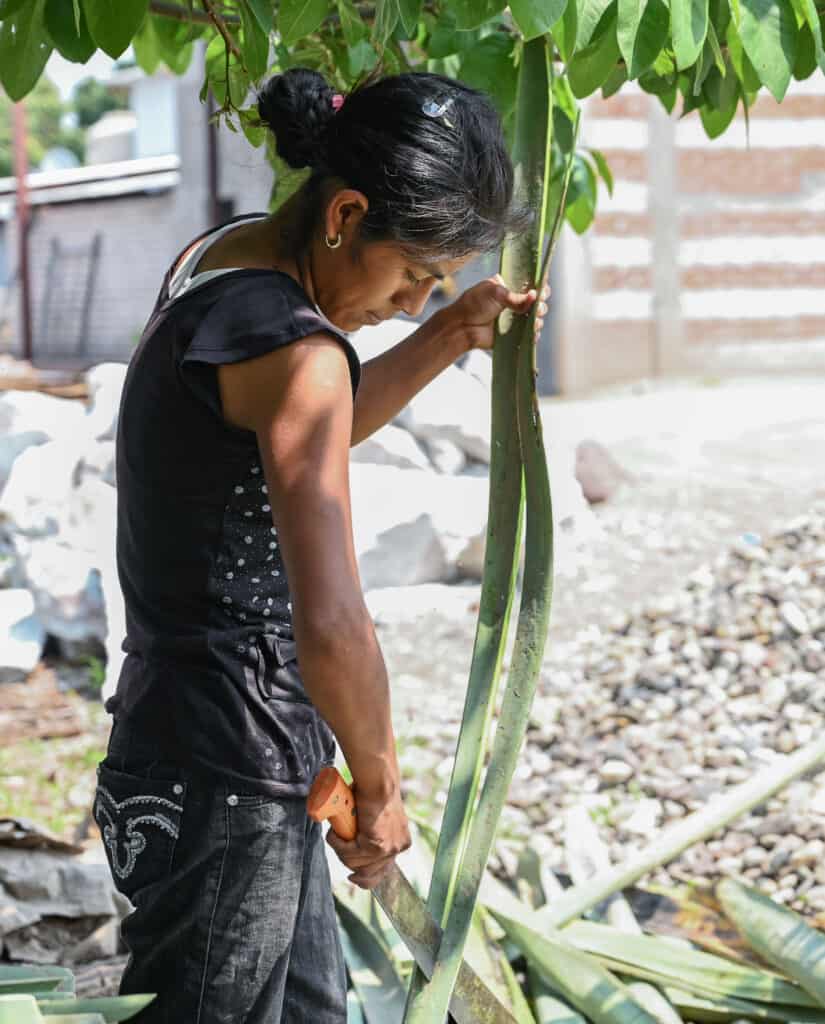



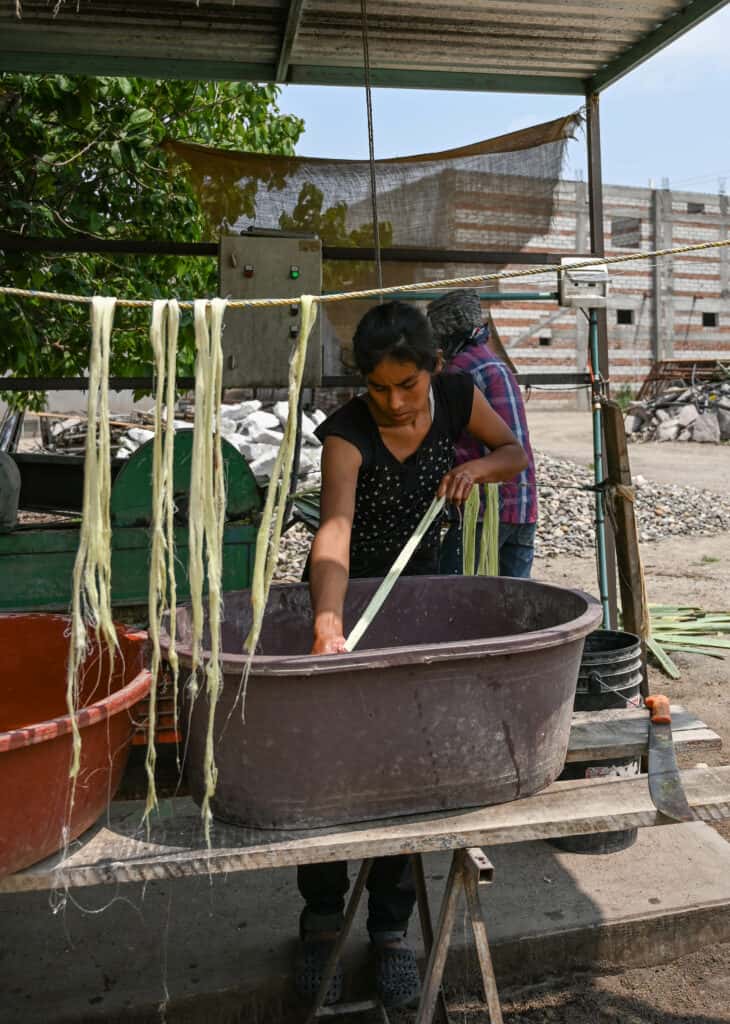
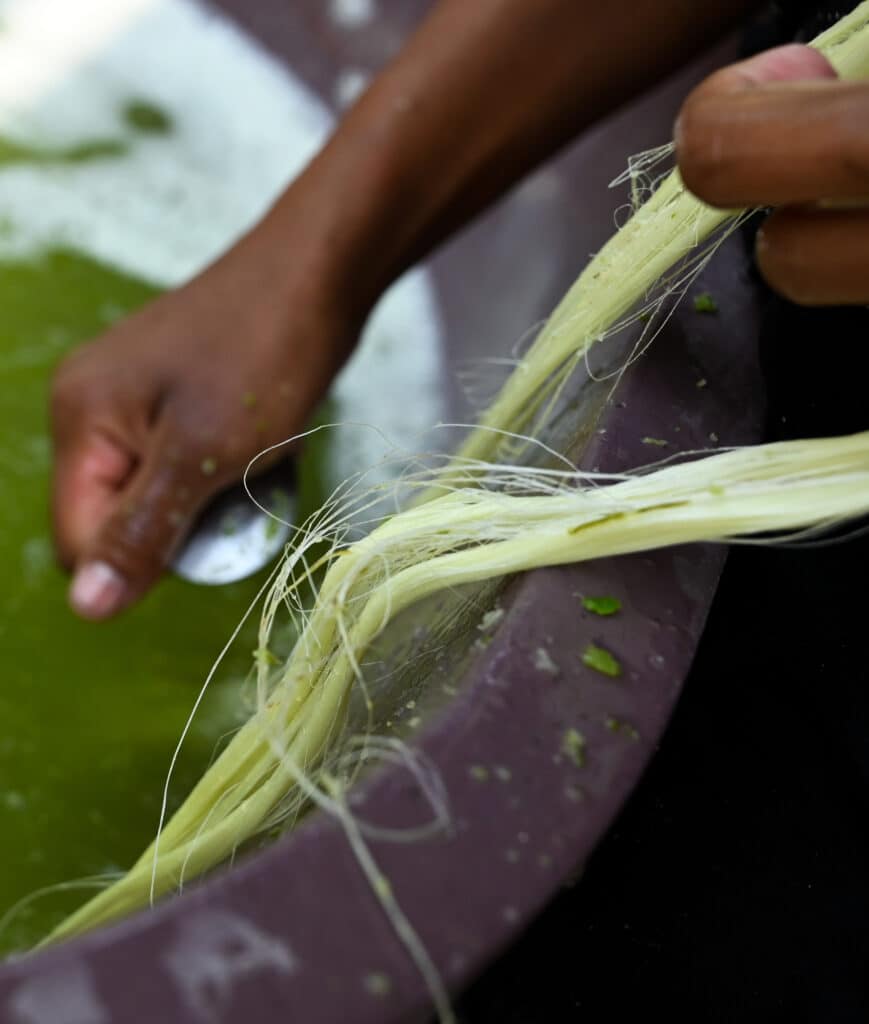
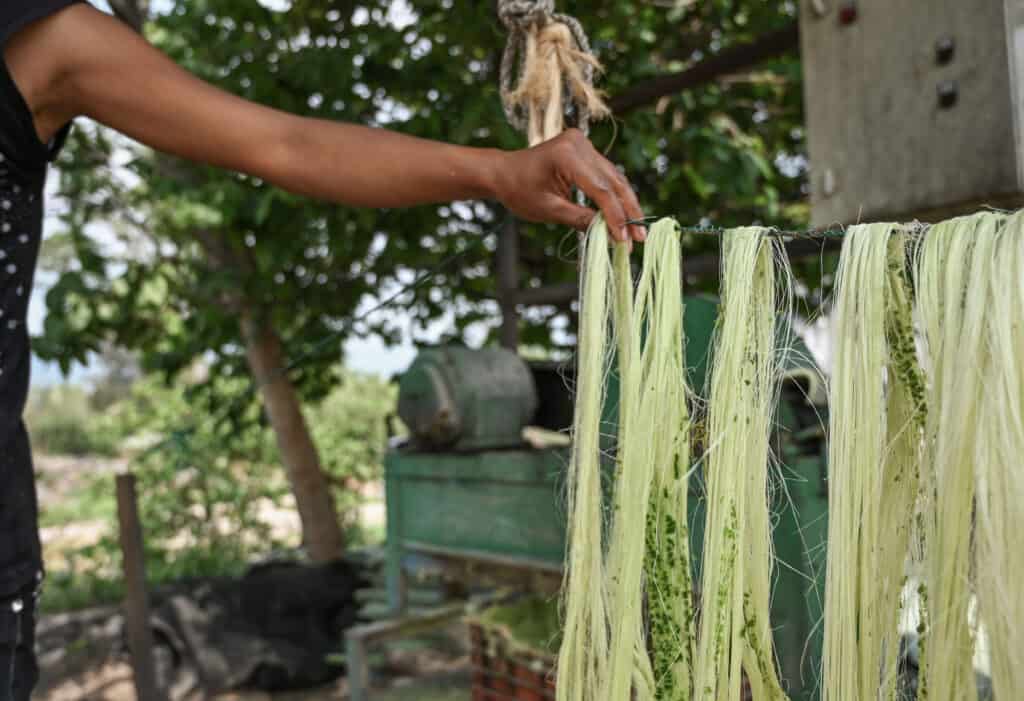

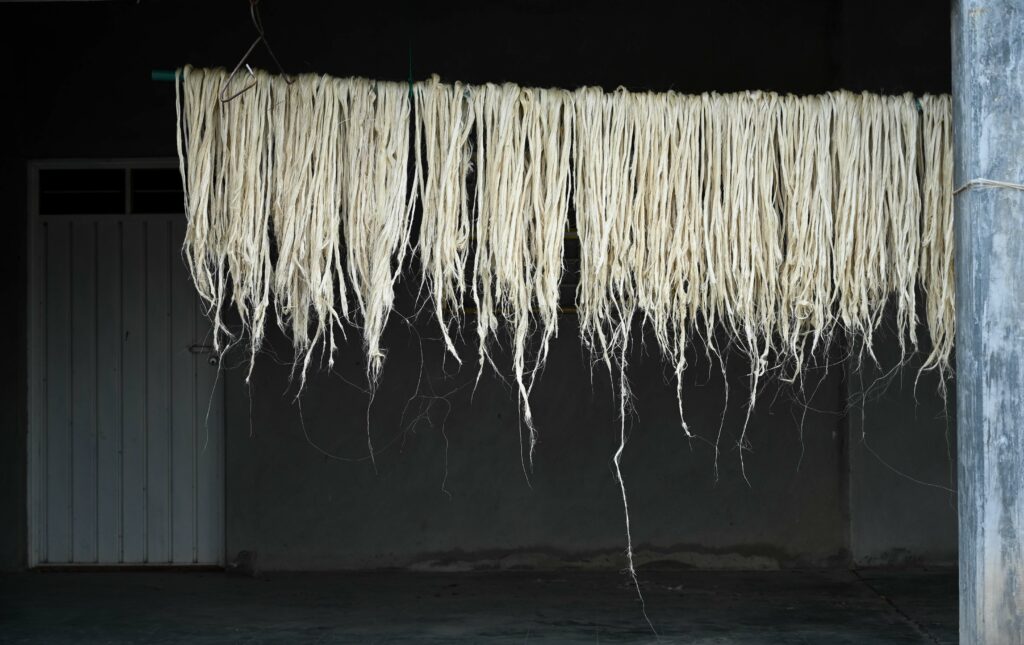
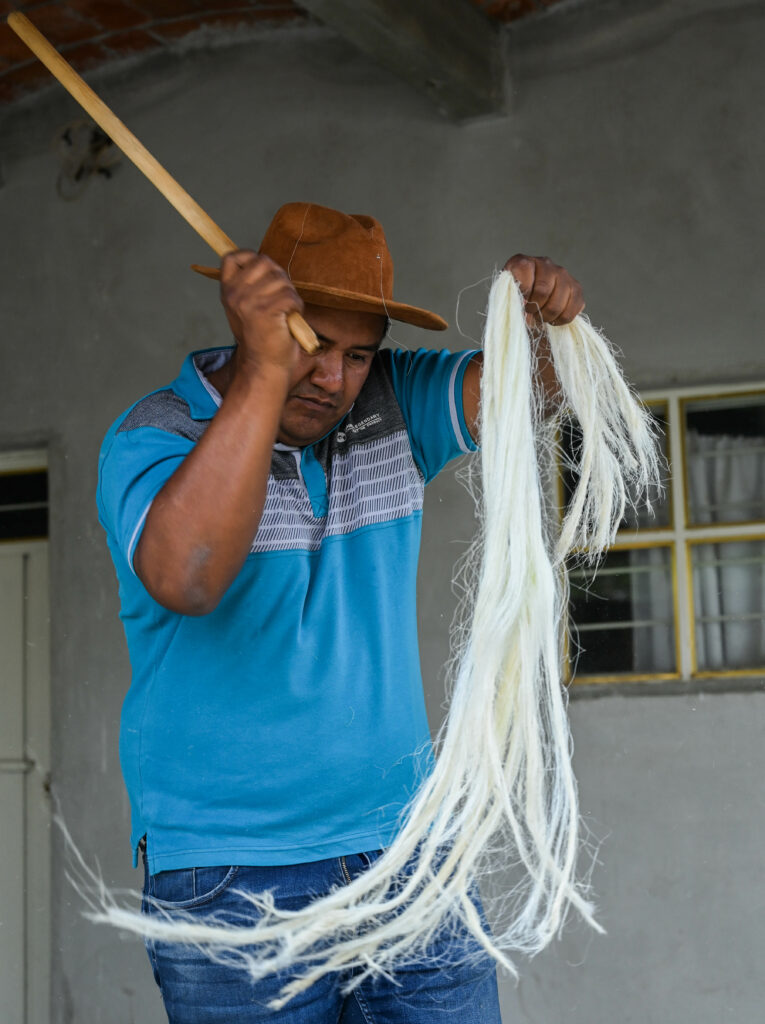
THE ECONOMIC OPPORTUNITIES
As mezcal production has boomed, the area of Matatlan is the most affected by the negative impacts of discarded agave. This issue is compounded by the growth of the plastics industry, which has replaced the use of agave fibers, leading to a loss of local knowledge. Ellitsgaard describes how traditionally agave fibers were processed by campesinos around Matatlan. “They would go out to find the plant, take the leaves to the river where they would soak them for nine days until they became soft. Then they beat them to get the fiber out before spinning it. It was a long process to make a rope.”
For Ellitsgaard, once the fiber has been extracted, she needs to spin and weave the fibers. This is another process she seeks to outsource to artisans in Oaxaca. However, she describes this as challenging as not many people still have the knowledge or interest. Elitsgaard explained that it was hard to find people willing to spin as “historically it has a bad reputation economically,” considering the amount of time it takes to work with.
Hopefully as agave becomes a staple material in contemporary design there will be a trickle down effect from famous artists with gallery prices, to the creation of more approachable products, which could make artisans more interested in the process and material. An example of this would be furniture exhibited by designers like Angela Damman and Fernando Laposse, being reinterpreted for restaurant use in Oaxaca.
Laposse pursued extensive research into the context of materials with their historical and cultural connotations. This fueled a passion for sustainability and reversing the loss of biodiversity and community disenfranchisement. His “hairy” bench made from sisal (another agave fiber) presents the material in its raw state, demonstrating the simplicity of process from plant to final product.
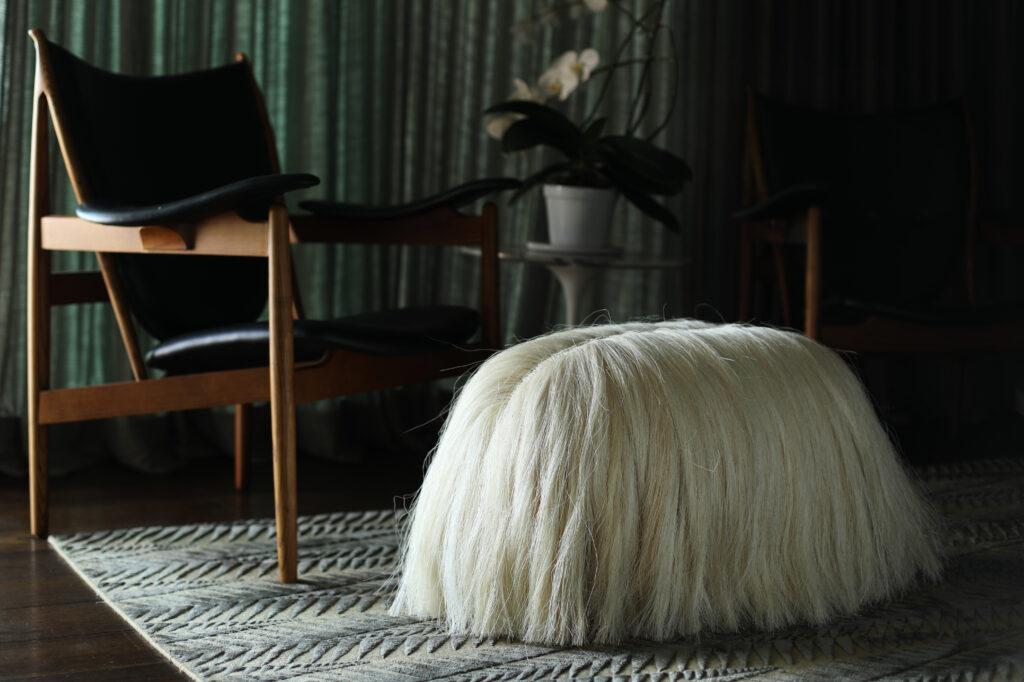
Much of Laposse’s work takes place with the community of Tonahuixtla, where his project generates higher incomes for many families. “Our main focus is their well-being and that of the environment.” He says that for him, “sustainability is not only very important in terms of material, but also the sustainability of a project. How can you grow on a scale that makes sense?”
Laposse explains that through his investigative practice, they have “successfully planted over 100,000 agaves covering an area of 180 hectares, increasing the water level in existing wells by 30%. This has in turn resulted in a massive decrease in plagues which were affecting the crops, and the establishment of new (insect eating) bat colonies in a virtuous cycle of circularity.” The project is financed through selling Laposse’s designs.
Elitsgaard’s work with agave fibers led to an exhibition in Chicago at Epiphany Center for the Art in Chicago in the United States in 2021, aptly named Agave! She invited artists to collaborate in this showcase of this ancient tradition in fiber. Artists included Damman and Laposse, who have also sourced fiber from Hermano Maguey.
Hermano Maguey states that “the key to bringing opportunities to our partner artisans is our commercial allies who are experts in reaching the right audiences.” Although Reyes recognizes the value in collaborating with artists that are creating a platform for agave fibers at an international level, Reyes is cautious of who they partner with. He is keen that relationships with Hermano Maguey not be used as a shorthand for brands to claim sustainable values in the aim to sell more products. He highlights that it is essential for respect of agave producers and those working with the fibers to be equal with designers and artists, while emphasizing that there should be appropriate credit given.
Elitsgaard recommended that I watch a film called Silvestre Pantleon, released in 2011. The story follows an elderly man as he struggles to provide for his family. He dedicates himself to the only remunerative activities he knows: handcrafting rope for religious ceremonies and building seldom used household objects that he alone still has the skills to produce. He enlists family members to help him gather maguey leaves in the hills, before stripping and cleaning the fibers to make rope.
The film received critical acclaim. A journal printed by the University of Chicago Press, describes it as surpassing the intention of documentary film, to “actively involve a community of speakers in a revitalization effort,” to both inform and inspire. This is different from solely capturing data. I think the experience of watching a story like Silvestre Pantaleon, can have a similar impact to experiencing a piece of art. Through creative techniques, art can inspire a different interaction from a purely educational exhibit. For me this is why recent artistic exploration of agave fibers helps to engage a positive future in design practices.
The Agave! exhibition in Chicago showcased creative uses of agave fibers by artists as well as some of the utilitarian ways it could be put to use as a sustainable material for the future. Elitsgaaard invited Aaron Robinson, founder of Mayahueltec, to exhibit prototypes from their bio-plastic venture. These include a range of items including cutlery and surfboard fins. The material is 30% waste agave fiber – specifically bagazo – and 100% biodegradable.
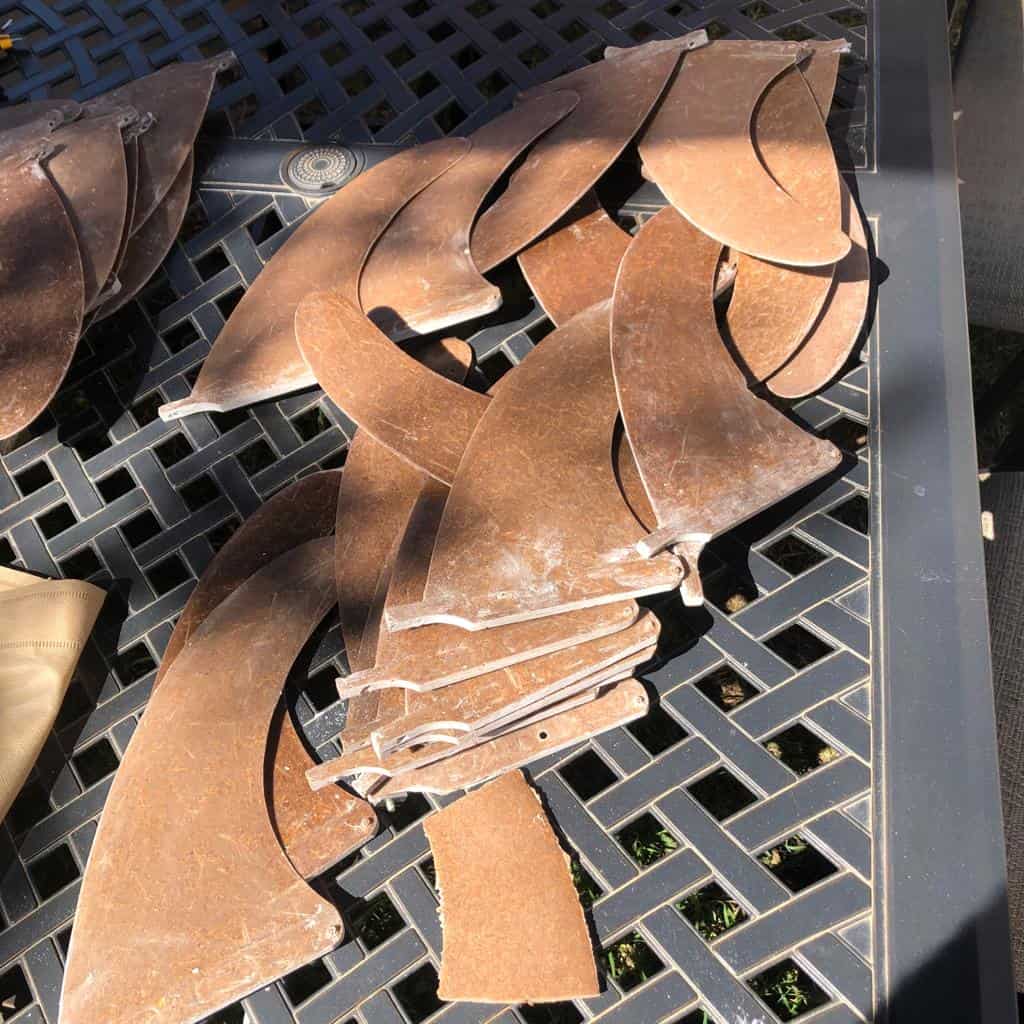
Bagazo is fibrous waste, left behind after the complete process of cooking, fermenting and distilling the agave plant. This can be used to make construction materials, specifically adobe blocks. Bagazo has evolved from a rustic option to a sought after aesthetic that is becoming prevalent in sustainably conscious constriction, emulated by projects like the Consultorio de Asesoria Arquitectonica or COAA.
Bagazo is also used to make a fibrous paper that is popular for mezcal labels. Brands are using this more and more as it is beautiful and speaks to the story of mezcal. It can also be interpreted as a shorthand for brands to let consumers know they are engaging with sustainable principles.
Hermano Maguey has some projects lined up for the future that include using bagazo for bio plastic, as well as the green residue from the leaves, which Ellitsgaard has tested as a material to fix artisanal tiles. The goal is to utilize as much of the waste from mezcal production as possible, as well as to motivate a circular market around the fibers that will help magueyeros from being trapped by a boom and bust cycle of the agave spirits market.
Ellitsgaard has been in discussion with the team of Hermano Maguey about fresh exploration of the Agave! exhibition at Centro de las Artes in Oaxaca, to bring the dialogue around the potential of the fibers to a local audience. Ideally this would open the doors to a platform where artists and designers can interact with mezcaleros and magueyeros on the doorstep of where these fibers have been harvested for thousands of years. Exploring the diverse use of agave is exciting and vital. Artists like Ellitsgaard and Laposse engage consumers at an intellectual level, while projects such as Hermano Maguey help revive traditional knowledge. Their collective work will support efforts to make the agave industry more reliable and sustainable, as interest in agave spirits continues to grow.

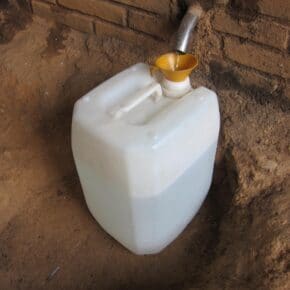
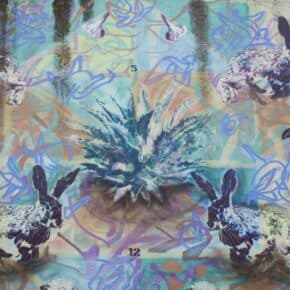
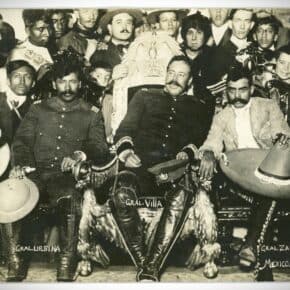








Leave a Comment